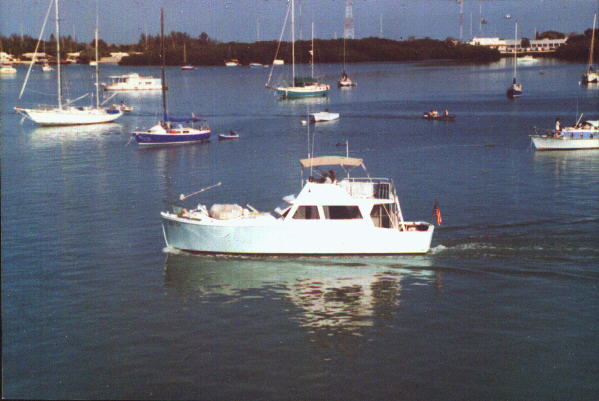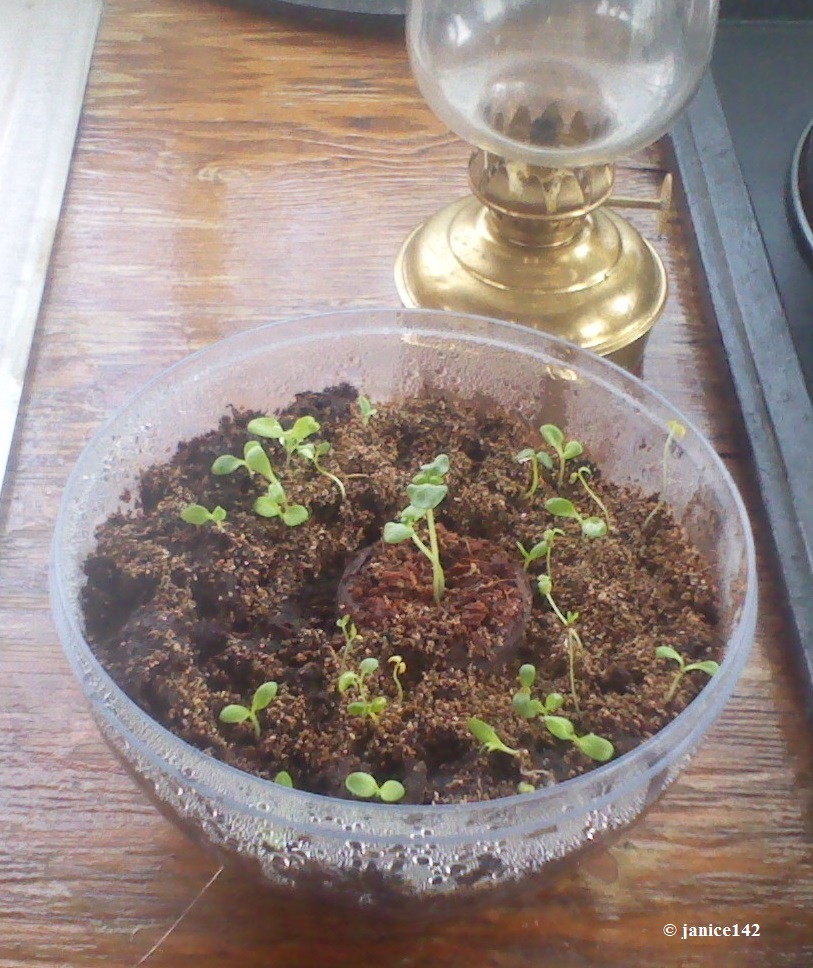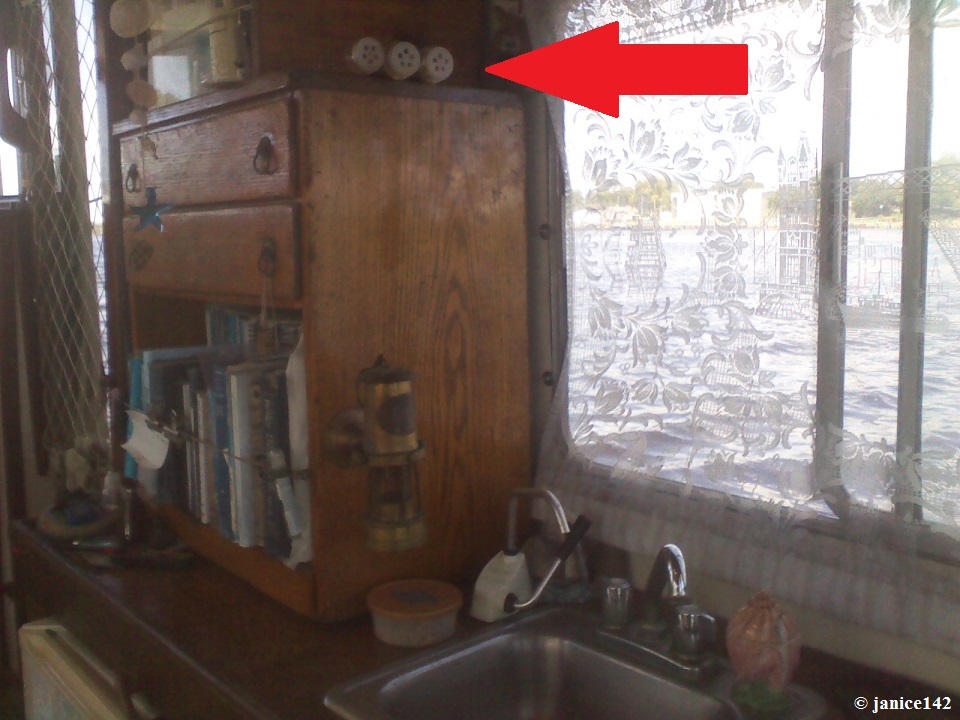![]() Home |
The Boat |
First Mate
|
Admiral |
Guestbook
Home |
The Boat |
First Mate
|
Admiral |
Guestbook
Date: 25 September 2013. Growing Lentil Sprouts.
© janice142
Preparing for a life afloat is a big job, and one thing I do might help you as you begin the road to living life on the water. Of course reading books is helpful in getting a flavor of what is out here. Still there are mistakes made time and again by newbie boat buyers. Because I was born (conceived too -- made the Log Book) and raised aboard a 40' motor vessel you might think I would be immune to all mistakes. Well, would be great if only it was true. I am here to tell you that boat life does not work quite that way.
And if you are curious, this was our family home for nearly
50 years:

One of the first/most common mistakes people make is in buying items for the boat before the boat is purchased. Mine was a 12-volt water heater. I paid nearly $250 on sale for it. Oh, it was great: theoretically my heat exchanger water would pass thru the $250 water heater, thus saving power and heating water for my showers. How that was going to be accomplished when the engine in my Seaweed lacked a heat exchanger, I am not quite certain. Argh.The spiffy new heater was never installed but out of the box, I managed to get $50 for the thing and was grateful too. It's just that I was so sure that I could only be happy with a plentitude of hot water....
So be smarter than I was and do not buy boat gear until you have actually lived aboard your home for a time and determined whatever you want is necessary. There are exceptions of course, but as a general rule of thumb do not spend a dime, and definitely do what I did which was pay retail.
That said, I would recommend a couple of books to give you a flavor of what it is really like out here. One is Clare Allcard's The Intricate Art of Living Afloat and although written quite some time ago offers a true perspective of life aboard a boat, raising children onboard while underway, chartering, provisioning, living without refrigeration and such. What I like best though is the friendly tone she uses throughout, and the fact that when presented with a problem her first solution isn't to buy something. I'd love to have her aboard my home for a spot of tea....
As for the second book I'd suggest Tricks of the Trades by Bruce Van Sant. This one offers guidance as to determining the type of cruising you wish to do, and advocates the leisurely style I prefer. [He's also the author of The Gentleman's Guide to Passages South that boaters use when heading down the Caribbean island chain.] I like Tricks.
 The Intricate Art of Living Afloat by Clare Allcard |
 Tricks of the Trades by Bruce Van Sant |
 The Gentleman's Guide to Passages South: The Thornless Path to Windward (Volume 10) |
Let me state unequivocally that you should not read any survival or shipwreck stories. Cruising coastal means we are in safe waters and as long as we watch for weather windows we should never experience the sort of things that appear in those nightmare books. After gaining experience if you still chose to head off across oceans and such, then read the stormy weather/sinking stories. [By then you will have enough practical knowledge to properly evaluate and use the information provided.]
Regarding food: For me, because my refrigeration is sporadic at best (battery issues) I have had to make a few alterations to insure I eat properly. One thing that is important is to have fresh produce and for that I have a system.
Unfortunately I am at an age where roughage must be a part of my diet. I have discovered lentils to be just the right solution. On a boat they are easy to store (dried beans do not take much space) and the price is great, they poof up nicely and, well, I like the way they taste when grown as sprouts.
Cooked though? Well, let us just say I prefer food with texture and lentils do not have much though they are nutritionally decent when cooked. As an aside, they finish in the same amount of time as rice so can be cooked together if you are of a mind for the combination.
As you can see I grow my lentil sprouts in spice jars. The larger flat container with the holes punched in the top is where I dump the extras when I grow more than I eat. I've found adding a small pouch of tuna fish, some mayo and a bit of fresh scallions makes a wonderful, tasty lunch (or supper) with minimal effort.
Oh, and the yellow container in the back holds one pound of lentils. I met a charming couple with a pair of young boys on a C-Dory back when I anchored in Saul Creek and they were nice enough to pass along their galley goods as their vacation was ending; later that day they were driving back to Texas. The groceries saved me having to leave (the spot was so tranquil I did not want to go) and their generosity in passing along the food stores allowed me to remain another week. I made use of the food (some shared, most eaten) and saved the pancake mix container. That one is ideal for pouring lentils into the spice jars and using it allows me to remember their kindness. It fits one pound of lentils.

Tuna fish mixed with lentil sprouts, scallions and
mayonnaise makes a refreshing meal.
This is my method for growing snack size portions that work for me. Of course if you were feeding a spouse also or someone who ate more, you would want to use larger containers. And instead of using the spice shaker tops you'd have to use screen for draining -- rubber bands will hold on the screen at least temporarily. For me however, spice bottles work perfectly. I have switched to bottles with all the same size lids (easier) and please note the holes in the tops are large enough to dump out water yet small enough that the lentil seeds do not fall out.
| Dried lentils - pour in approximately 1/4" |
Add water up to
about one inch level. Drain in 3 hours. |
Time after initial soaking: |
 |
 |
 12, 24 and 36 hours |
As you can see lentils grow rapidly and in two days will top out the spice jar! The sprouts will continue to grow however I like them with just a hint of the greenery (the root starts first) so at day two, I'm snacking away. I have grown them thru day four -- the flavor is more "grassy" if that makes sense. Anyway, you can try these for yourself and see what you prefer.
For me this is a great way to enjoy a healthy snack, get roughage into the diet plus I rather like them. Day two seems to have the nutty flavor I savor most. I have tossed them in chicken salads, added to tuna fish, used them as crunch in ham sandwiches, and mixed them into my crab meat salads. You are only limited by your imagination!
Now, for the nitty-gritty: Water. Away from docks and such we are limited by water availability. Everything used aboard Seaweed has to be hauled out to the boat for the most part and rinsing the sprouts is necessary. Morning and night (twice per day) this is how I do it:
Pour fresh water to cover the sprouts in the fullest container.
Shake, then drain the water into a dish.
Dump that water into the next fullest.
Repeat thru your stock of sprouts adding water as necessary.
After I have rinsed all my sprouts with the same water, I pour the nutrient rich leftover water onto my planter. I have an old terracotta flower pot that has both basil and scallions growing in it. Having aboard fresh spice (basil though when the new seed packets come out I will try oregano and sage too) is fun -- and it is extra delightful to be able to share with friends.
SHH! I've got five small egg containers growing to give to friends I have made while here in Carrabelle. Basil in the center with tiny flower seedlings surrounding same. Here is what they look like:
My lentil growing system has one flaw, as illustrated below. I like having the containers on edge as it allows lots of air flow but, well, take a look at the red arrow. They aren't stowed properly and if I were to want to get underway immediately I will have to do something with them. There is a piece of red oak that they back up to but still my system is not right. I've not yet come up with a solution I like so am open to your ideas. I am a nut of having things put away and tidy -- and if someone comes by a wakes me (the boat rocks) I do not want to be catching stuff. That is the criteria. What would you do or make?
That's it from the water tonight. Until next time...
Ladies, and gents who live aboard: are there any books you you recommend for folks who are thinking about/planning to live on a boat?
Pre-purchase, is there anything you bought that could best be described as ballast?
|
Regarding the Comments Section, found at the end of every article:
|
COMMENTS:
© 2013, 2018, 2020, 2023
Categories: Anchorages, Boats, Books, Galley, Locations, Money,
Prepping - Plastics ~
Previous Post ... ![]() ... Next Post ~
Boatyard Blues
... Next Post ~
Boatyard Blues
The Archive holds a running list with synopsis of published articles, and links to same.
A favorite aphorism: If you are what you eat, then I only wanna eat the good stuff. Ratatouille, by Disney.
Every gift helps.
The Cruising Kitty is what boaters refer to as spending money. There's never enough aboard Seaweed!
I am also an Amazon Affiliate.









